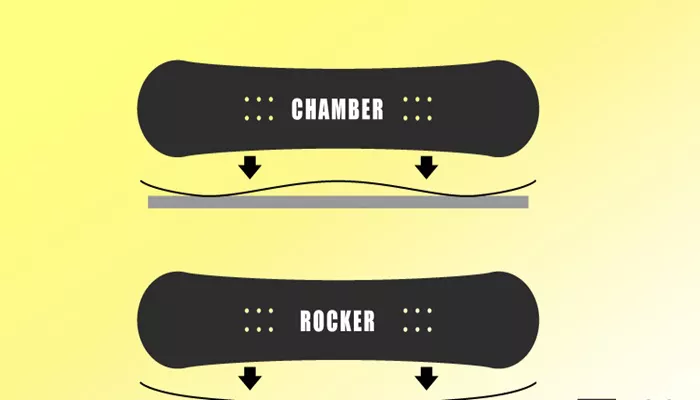Rocker snowboards continue to dominate the freestyle and powder scenes, offering unmatched float, playful control, and catch-free performance. The 2025 lineup brings refinement, innovation, and bold design to this already popular category. Whether you’re a park junkie, powder hound, or all-mountain explorer, there’s a rocker board crafted for your ride style. In this article, we break down the snowboarding gear world to highlight the seven standout rocker snowboards of the year.The
The 7 Rocker Snowboards of 2025
1. Burton Process Flying V
The Burton Process Flying V returns with upgrades tailored for 2025. Built for intermediate to advanced riders, its hybrid Flying V profile—rocker between the feet, camber underfoot—offers a nimble, poppy, and surfy ride. A Super Fly II 700G core and dualzone EGD give it responsiveness and strength, while the Squeezebox core profiling boosts edge control.
This board excels in varied terrain. Whether you’re dropping into powder or hitting park transitions, the Burton Process Flying V remains light and lively underfoot. Its true twin shape ensures consistent performance switch or regular.
2. Lib Tech Skate Banana
The iconic Skate Banana by Lib Tech stays true to its roots but adds more finesse for 2025. The Original Banana profile blends rocker between the bindings with mild camber underfoot. Magne-Traction edges cut into hardpack and ice like a serrated knife, making it incredibly stable for a rocker board.
This freestyle-focused board is versatile and forgiving. Great for beginners stepping into freestyle, it also satisfies seasoned park riders craving pop and playfulness. Eco-conscious riders will appreciate its sustainably harvested wood core and eco-sublimated graphics.
3. GNU Head Space
The GNU Head Space, designed by Forest Bailey, is one of the most progressive true twin freestyle boards on the market. Its C3 Camber/Rocker blend leans more toward camber but includes rocker between the bindings for a looser, skate-style feel. For 2025, it features enhanced edge tech and lighter construction.
Perfect for creative street riders and park obsessives, the Head Space is quick, snappy, and presses like a dream. Magne-Traction edges and an asymmetrical sidecut make it agile and grippy. Its graphic this season also turns heads—it’s art on snow.
4. Jones Twin Sister
Female riders who want a surfy, floaty board with serious all-mountain credentials will love the 2025 Jones Twin Sister. Designed as a true twin with a rocker profile at the tip and tail, camber between the bindings, and Traction Tech 3.0 edges, it’s playful but confident across all conditions.
The bamboo wood core and sustainable construction emphasize both performance and responsibility. From tree lines to terrain parks, the Twin Sister delivers stable, stylish fun without sacrificing control. Its stance width and flex are optimized for female anatomy, ensuring comfort and response.
5. Never Summer Proto Synthesis
Never Summer’s Proto Synthesis uses their Shockwave Rocker Camber profile, a dynamic blend of rocker and camber zones designed for stability, edge grip, and explosive pop. It’s the board of choice for aggressive riders seeking high-speed performance with rocker-style play.
In 2025, the Proto Synthesis gets lighter and more responsive thanks to advanced carbon stringers and new damping systems. Perfect for riders who want one board to ride everything. Edge hold, carving precision, and freestyle capability meet in this all-mountain monster.
6. Arbor Element Rocker
A timeless name in rocker snowboards, the Arbor Element Rocker blends natural materials with performance-driven design. Its Parabolic Rocker profile gradually decreases the rocker toward the tips, enhancing edge hold without sacrificing that buttery feel.
The Highland II Core, made from sustainably grown poplar, ensures lightweight strength. Arbor’s signature Grip Tech edges provide added contact points for more control. This board is ideal for intermediate riders who want a smooth, surf-like experience with all-mountain capabilities.
7. Capita Pathfinder Reverse
The Capita Pathfinder Reverse is a budget-friendly rocker board with impressive specs. Designed for urban, park, and resort fun, its reverse camber profile offers a catch-free ride, making it ideal for progression and creativity.
New for 2025, it features upgraded FSC Certified core materials and fast sintered base. A true twin shape, lightweight body, and moderate flex make it an excellent option for beginner to intermediate riders looking to master presses, butters, and rails.
How to Choose a Rocker Snowboard
With many options available, it’s essential to choose a board that fits your style. Here’s what to consider:
Flex
Softer boards suit freestyle riding and beginners. Stiffer boards provide better stability at speed and more aggressive carving.
Profile
Pure rocker offers maximum float and playfulness. Hybrid designs blend camber and rocker for more stability and edge control.
Terrain
Choose a profile based on where you ride most. Powder riders benefit from directional rocker, while park riders enjoy twin shapes with freestyle flex.
Rider Level
Beginners will appreciate the forgiveness of full rocker or hybrid rocker boards. Advanced riders may prefer more aggressive profiles with added camber zones.
Conclusion
The 2025 season is packed with advanced, fun-forward rocker snowboards tailored for different terrain, riding styles, and skill levels. Whether you’re crushing corduroy, hunting pillow lines, or perfecting your rail game, the right board is waiting.
The seven rocker snowboards above each bring something unique—performance, sustainability, value, or style—and all have earned their place among the year’s best.

